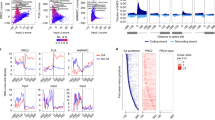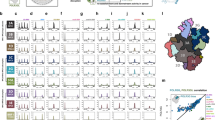Abstract
A 42 kb region on human chromosome 9p21 encodes for three distinct tumor suppressors, p16INK4A, p14ARF and p15INK4B, and is altered in an estimated 30–40% of human tumors. The expression of the INK4A-ARF-INK4B gene cluster is silenced by polycomb during normal cell growth and is activated by oncogenic insults and during aging. How the polycomb is recruited to repress this gene cluster is unclear. Here, we show that expression of oncogenic Ras, which stimulates the expression of p15INK4B and p16INK4A, but not p14ARF, inhibits the expression of ANRIL (antisense non-coding RNA in the I NK4 locus), a 3.8 kb-long non-coding RNA expressed in the opposite direction from INK4A-ARF-INK4B. We show that the p15INK4B locus is bound by SUZ12, a component of polycomb repression complex 2 (PRC2), and is H3K27-trimethylated. Notably, depletion of ANRIL disrupts the SUZ12 binding to the p15INK4B locus, increases the expression of p15INK4B, but not p16INK4A or p14ARF, and inhibits cellular proliferation. Finally, RNA immunoprecipitation demonstrates that ANRIL binds to SUZ12 in vivo. Collectively, these results suggest a model in which ANRIL binds to and recruits PRC2 to repress the expression of p15INK4B locus.
This is a preview of subscription content, access via your institution
Access options
Subscribe to this journal
Receive 50 print issues and online access
$259.00 per year
only $5.18 per issue
Buy this article
- Purchase on Springer Link
- Instant access to full article PDF
Prices may be subject to local taxes which are calculated during checkout




Similar content being viewed by others
References
Agger K, Cloos PA, Rudkjaer L, Williams K, Andersen G, Christensen J et al. (2009). The H3K27me3 demethylase JMJD3 contributes to the activation of the INK4A-ARF locus in response to oncogene- and stress-induced senescence. Genes Dev 23: 1171–1176.
Bracken AP, Kleine-Kohlbrecher D, Dietrich N, Pasini D, Gargiulo G, Beekman C et al. (2007). The polycomb group proteins bind throughout the INK4A-ARF locus and are disassociated in senescent cells. Genes & Dev 21: 525–530.
Broadbent HM, Peden JF, Lorkowski S, Goel A, Ongen H, Green F et al. (2008). Susceptibility to coronary artery disease and diabetes is encoded by distinct, tightly linked SNPs in the ANRIL locus on chromosome 9p. Hum Mol Genet 17: 806–814.
Cao R, Tsukada Y, Zhang Y . (2005). Role of Bmi-1 and Ring1A in H2A ubiquitylation and Hox gene silencing. Mol Cell 20: 845–854.
Gil J, Peters G . (2006). Regulation of the INK4b-ARF-INK4a tumour suppressor locus: all for one or one for all. Nat Rev Mol Cell Biol 7: 667–677.
Gupta RA, Shah N, Wang KC, Kim J, Horlings HM, Wong DJ et al. (2010). Long non-coding RNA HOTAIR reprograms chromatin state to promote cancer metastasis. Nature 464: 1071–1076.
Helgadottir A, Thorleifsson G, Manolescu A, Gretarsdottir S, Blondal T, Jonasdottir A et al. (2007). A common variant on chromosome 9p21 affects the risk of myocardial infarction. Science 316: 1491–1493.
Itahana K, Zou Y, Itahana Y, Martinez JL, Beausejour C, Jacobs JJ et al. (2003). Control of the replicative life span of human fibroblasts by p16 and the polycomb protein Bmi-1. Mol Cell Biol 23: 389–401.
Jacobs JJ, Kieboom K, Marino S, DePinho RA, van Lohuizen M . (1999). The oncogene and polycomb-group gene bmi-1 regulates cell proliferation and senescence through the ink4a locus. Nature 397: 164–168.
Kamijo T, Zindy F, Roussel MF, Quelle DE, Downing JR, Ashmun RA et al. (1997). Tumor suppression at the mouse INK4a locus mediated by the alternative reading frame product p19ARF. Cell 91: 649–659.
Kia SK, Gorski MM, Giannakopoulos S, Verrijzer CP . (2008). SWI/SNF mediates polycomb eviction and epigenetic reprogramming of the INK4b-ARF-INK4a locus. Mol Cell Biol 28: 3457–3464.
Kim WY, Sharpless NE . (2006). The Regulation of INK4/ARF in cancer and aging. Cell 127: 265–275.
Kotake Y, Cao R, Viatour P, Sage J, Zhang Y, Xiong Y . (2007). pRB family proteins are required for H3K27 trimethylation and Polycomb repression complexes binding to and silencing p16INK4a tumor suppressor gene. Genes Dev 21: 49–54.
Kotake Y, Zeng YX, Xiong Y . (2009). DDB1-CUL4 and MLL1 mediate oncogene-induced p16(INK4a) activation. Cancer Res 69: 1809–1814.
Krimpenfort P, Ijpenberg A, Song JY, van der Valk M, Nawijn M, Zevenhoven J et al. (2007). p15Ink4b is a critical tumour suppressor in the absence of p16Ink4a. Nature 448: 943–946.
Krimpenfort P, Quon KC, Mooi WJ, Loonstra A, Berns A . (2001). Loss of p16Ink4a confers susceptibility to metastatic melanoma in mice. Nature 413: 83–86.
Krishnamurthy J, Torrice C, Ramsey MR, Kovalev GI, Al-Regaiey K, Su L et al. (2004). Ink4a/Arf expression is a biomarker of aging. J Clin Invest 114: 1299–1307.
Malumbres M, Perez De Castro I, Hernandez MI, Jimenez M, Corral T, Pellicer A . (2000). Cellular response to oncogenic ras involves induction of the Cdk4 and Cdk6 inhibitor p15(INK4b). Mol Cell Biol 20: 2915–2925.
McPherson R, Pertsemlidis A, Kavaslar N, Stewart A, Roberts R, Cox DR et al. (2007). A common allele on chromosome 9 associated with coronary heart disease. Science 316: 1488–1491.
Nagano T, Mitchell JA, Sanz LA, Pauler FM, Ferguson-Smith AC, Feil R et al. (2008). The Air noncoding RNA epigenetically silences transcription by targeting G9a to chromatin. Science 322: 1717–1720.
Pandey RR, Mondal T, Mohammad F, Enroth S, Redrup L, Komorowski J et al. (2008). Kcnq1ot1 antisense noncoding RNA mediates lineage-specific transcriptional silencing through chromatin-level regulation. Mol Cell 32: 232–246.
Pasmant E, Laurendeau I, Heron D, Vidaud M, Vidaud D, Bieche I . (2007). Characterization of a germ-line deletion, including the entire INK4/ARF locus, in a melanoma-neural system tumor family: identification of ANRIL, an antisense noncoding RNA whose expression coclusters with ARF. Cancer Res 67: 3963–3969.
Rinn JL, Kertesz M, Wang JK, Squazzo SL, Xu X, Brugmann SA et al. (2007). Functional demarcation of active and silent chromatin domains in human HOX loci by noncoding RNAs. Cell 129: 1311–1323.
Saxena R, Voight BF, Lyssenko V, Burtt NP, de Bakker PI, Chen H et al. (2007). Genome-wide association analysis identifies loci for type 2 diabetes and triglyceride levels. Science 316: 1331–1336.
Scott LJ, Mohlke KL, Bonnycastle LL, Willer CJ, Li Y, Duren WL et al. (2007). A genome-wide association study of type 2 diabetes in Finns detects multiple susceptibility variants. Science 316: 1341–1345.
Serrano M, Lee H-W, Chin L, Cordon-Cardos C, Beach D, DePinho RA . (1996). Role of the INK4a locus in tumor suppression and cell mortality. Cell 85: 27–37.
Sharpless NE, Bardeesy N, Lee KH, Carrasco D, Castrillon DH, Aguirre AJ et al. (2001). Loss of p16Ink4a with retention of p19Arf predisposes mice to tumorigenesis. Nature 413: 86–91.
Sherr CJ . (1998). Tumor surveillance via the ARF-p53 pathway. Genes Dev 12: 2984–2991.
Terranova R, Yokobayashi S, Stadler MB, Otte AP, van Lohuizen M, Orkin SH et al. (2008). Polycomb group proteins Ezh2 and Rnf2 direct genomic contraction and imprinted repression in early mouse embryos. Dev Cell 15: 668–679.
Visel A, Zhu Y, May D, Afzal V, Gong E, Attanasio C et al. (2010). Targeted deletion of the 9p21 non-coding coronary artery disease risk interval in mice. Nature 464: 409–412.
Wang L, Brown JL, Cao R, Zhang Y, Kassis JA, Jones RS . (2004). Hierarchical recruitment of polycomb group silencing complexes. Mol Cell 14: 637–646.
Wutz A, Rasmussen TP, Jaenisch R . (2002). Chromosomal silencing and localization are mediated by different domains of Xist RNA. Nat Genet 30: 167–174.
Yap KL, Li S, Munoz-Cabello AM, Raguz S, Zeng L, Mujtaba S et al. (2010). Molecular interplay of the noncoding RNA ANRIL and methylated histone H3 lysine 27 by polycomb CBX7 in transcriptional silencing of INK4a. Mol Cell 38: 662–674.
Zhao J, Sun BK, Erwin JA, Song JJ, Lee JT . (2008). Polycomb proteins targeted by a short repeat RNA to the mouse X chromosome. Science 322: 750–756.
Zindy F, Quelle DE, Roussel MF, Sherr CJ . (1997). Expression of the p16INK4a tumor suppressor versus other INK4 family members during mouse development and aging. Oncogene 15: 203–211.
Acknowledgements
We thank Howard Chang for the insightful discussion during this study, Yaxue Zeng and Matt Smith for helpful discussion and reading the manuscript, Mika Matsumoto, Michiyo Hakamata and Harumi Shiratori for technical assistance. This study is supported by grants from the Ministry of Education, Science, Sports, Culture, and Technology of Japan (YK, MK, SS and KK) and NIH grant CA68377 (YX).
Author information
Authors and Affiliations
Corresponding authors
Ethics declarations
Competing interests
The authors declare no conflict of interest.
Additional information
Supplementary Information accompanies the paper on the Oncogene website
Supplementary information
Rights and permissions
About this article
Cite this article
Kotake, Y., Nakagawa, T., Kitagawa, K. et al. Long non-coding RNA ANRIL is required for the PRC2 recruitment to and silencing of p15INK4B tumor suppressor gene. Oncogene 30, 1956–1962 (2011). https://doi.org/10.1038/onc.2010.568
Received:
Revised:
Accepted:
Published:
Issue Date:
DOI: https://doi.org/10.1038/onc.2010.568
Keywords
This article is cited by
-
Genetik, Epigenetik und Umweltfaktoren der Lebenserwartung – Welche Rolle spielt Nature-versus-Nurture beim Altern?
Bundesgesundheitsblatt - Gesundheitsforschung - Gesundheitsschutz (2024)
-
LncRNA LINC00969 promotes acquired gefitinib resistance by epigenetically suppressing of NLRP3 at transcriptional and posttranscriptional levels to inhibit pyroptosis in lung cancer
Cell Death & Disease (2023)
-
Reduced LHFPL3-AS2 lncRNA expression is linked to altered epithelial polarity and proliferation, and to ileal ulceration in Crohn disease
Scientific Reports (2023)
-
Long noncoding RNAs as regulators of pediatric acute myeloid leukemia
Molecular and Cellular Pediatrics (2022)
-
Genetic and molecular biology of gastric cancer among Iranian patients: an update
Egyptian Journal of Medical Human Genetics (2022)



